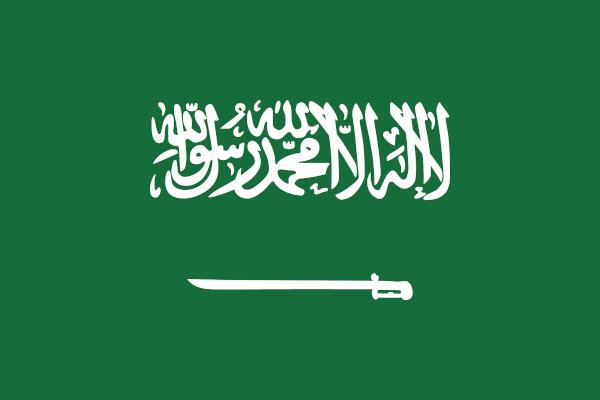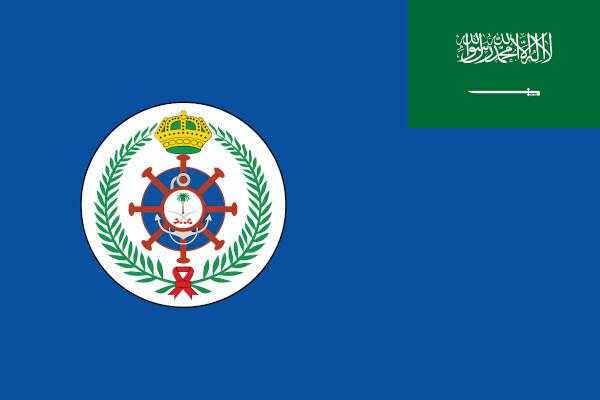A flag of Saudi Arabia It is one of the country's national symbols. Its first version was instituted in 1932, when the Kingdom of Saudi Arabia was founded, while the current version of the flag was adopted a few decades later, in 1973. The flag of Saudi Arabia features green color, which is predominant, representing the Islamic religion. White prints are shahada, which consists of the first principle of Islam, and just below the sword that symbolizes justice, strength and power of Saudi Arabia.
Read too: Flag of Mexico — a flag that represents the freedom of the country and the unity of the people
Saudi Arabia flag abstract
The flag of Saudi Arabia is one of the country's national symbols.
It consists of a rectangle in the predominant green color and two important symbols made in white in the center of the flag. The first of them is an Arabic inscription, and the second is a sword.
The green color is representative of the islamism, the official religion of Saudi Arabia. It represents the prophet Mohammed, chosen by Allah. Other interpretations also say that the color is linked to Mohammed's youngest daughter, Fatima.
The inscription in white in the center of the flag is called shahada and consists of the first pillar of Islam. Translates to: “There is no god but Allah, and Mohammed is his prophet.”
A sword with the blade pointed to the left is positioned below the inscription, representing the strength, justice and power of Saudi Arabia.
The first official flag of Saudi Arabia was adopted in 1932. The inscription in Arabic and the sword were already present, with a white lateral band positioned on the right.
The current version of the flag of Saudi Arabia was officially adopted on March 15, 1973.
Saudi Arabia flag meaning
The flag of the Kingdom of Saudi Arabia is one of the country's national symbols. The meaning of the flag of Saudi Arabia is directly associated with islamand the fight for the union and formation of the current kingdom, with Islam being the country's official religion.
It is formed by a green rectangle on which there are elements engraved in white. The first of these is an Arabic inscription horizontally centered but slightly off-center on the vertical axis.
Immediately below the inscription appears the representation of a sword. The current composition of the pavilion has been used since 1932, when the Arabian Peninsula was unified and the country as we know it today was formed. Despite this, its current design was incorporated only in 1973.

Predominant on the flag of Saudi Arabia, The green color represents the Islamic religion and the prophet Muhammad (Mohammed, in Portuguese). According to Muslim belief, Mohammed she was chosen to preach the word of Allah. The revelations that Mohammed received, which began at the beginning of the seventh century, and later transcribed, gave rise to the Koran or Koran, the holy book of Islam.
It is also said that the color green is related to the youngest daughter of Mohammed, called Fatima (Fāṭimah), a very important figure for Islam and especially for Muslim women.
The sword that appears just below the Arabic inscription has its blade facing downwards and points to the left. The sword represents the justice, power and strength of Saudi Arabia.
What is written on the flag of Saudi Arabia?
The inscription present in the center of the flag of Saudi Arabia is named after shahada (or whahada). It is the first of the five pillars of the Islamic religion. and can be translated as follows:
“There is no god but Allah, and Mohammed is his prophet.”
A shahada it must be recited by all Muslims, therefore by all followers of the Islamic faith. Furthermore, its reading must be possible in any position. That's why the flag is made in such a way that the shahada it is understood regardless of the side on which it is read, obverse or reverse.
Saudi Arabia flag history
The current composition of the flag of Saudi Arabia, with the shahada and the sword centralized, officially started to be used from 1932, with the formation of the Kingdom of Saudi Arabia on September 22 of that same year.
In previous periods, however, the color green and the Islamic principle, so important for the followers of that faith, were already being used by the territories that were later unified.
Green had been adopted since at least the 18th century by followers of the Wahhabi movement, described as a conservative current that defends the roots of religion Islamic practice and the literal reading of the Koran and its sacred inscriptions, free from any kind of deviations or “impurities”. This current was founded by Muhammad ibn Abd al-Wahhab (1703-1792) and played an important role in the founding of present-day Saudi Arabia.
The kingdoms that were later incorporated into the territory of Saudi Arabia, becoming states, began to adopt green flags with the inscription in Arabic a from the domination of King Ibn Saud, with emphasis on the regions of Riyadh, conquered in 1902, Najd, Al-Ahsa, Asir and Hejad, the latter conquered after the end of First World War. It is in Hejad where the two most important cities within the Islamic religion are located, which are Mecca and Medina.

With the foundation of the Kingdom of Saudi Arabia in 1932, the flag with the current elements was officially adopted by the new country. However,The sword Pbore its upward curved blade and a white band appeared on the right side of the pavilion. The side stripe was removed from 1938 onwards, and after minor changes, the current version of the Saudi Arabian flag was adopted on March 15, 1973.
See too:Flag of Australia — symbol that has a strong influence of the flag of the United Kingdom
Main characteristics of Saudi Arabia
Saudi Arabia is a country located in the region of Middle East, between the Red Sea and the Persian Gulf, establishing land borders with Arab countries such as Yemen, Oman, United Arab Emirates, kuwait, Iraq, Jordan It is Israel. The Saudi capital is the city of Riyadh.

Located in the area of occurrence of the Arabian desert, one of the largest hot deserts in the world, in Saudi Arabia the predominant climate is theclimate desert, characterized by very low annual rainfall and high temperatures. It is characterized by a plateau relief and non-existent or scarce vegetation cover, with areas marked by the presence of steppes.
The Saudi economy is one of the largest in the Middle East, having the exploration and commercialization of Petroleum It is natural gas as flagships. It should be noted that Saudi Arabia is one of the founding members of the Organization of Petroleum Exporting Countries (OPEC) and is in second place among the largest oil producers in the world, behind only the U.S.
A population of Saudi Arabia is the fourth largest in the Middle East, reaching today 35,341,000 inhabitants. Most of this population lives in cities and in the southwestern part of the Arab territory.
The Islamic religion was established as the official religion of the country, followed by almost 90% of the Saudi population, which largely determines the customs and traditions of Saudi Arabia, which is known as a rather conservative country.
Other flags of Saudi Arabia
Other flags are used in Saudi Arabia besides the national flag. See some of them below.
→ Flag of the Royal Standard of Saudi Arabia
On the flag of the Royal Standard, in addition to the elements of the national flag, appears the emblem of Saudi Arabia in gold. The emblem consists of a palm tree over two crossed swords.
![Flag of the Royal Standard of Saudi Arabia. [1]](/f/a978cf1efc6df89161fd45c67447bf27.jpg)
→ Flag of the Land Branch of the Armed Forces of Saudi Arabia
![Flag of the Land Branch of the Armed Forces of Saudi Arabia. [2]](/f/fc1a14323d70b3ab21b6a4c20236959d.jpg)
→ Flag of the Saudi Arabian Navy

Facts about the flag of Saudi Arabia
The flag of Saudi Arabia must not fly at half-mast, even during periods of official mourning.
It is the only flag that features an inscription as a prominent symbol, although other Arab countries have phrases or words in smaller dimensions written on their flags.
Although the flag is made in such a way that the shahada be read and understood from any direction, the sword must always be obligatorily stamped from right to left, that is, with its blade pointing to the left.
image credits
[1] Wikimedia Commons (reproduction)
[2] Wikimedia Commons (reproduction)
By Paloma Guitarrara
Geography Teacher
Source: Brazil School - https://brasilescola.uol.com.br/geografia/bandeira-da-arabia-saudita.htm

